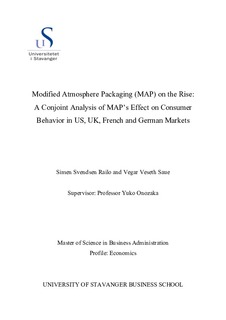| dc.contributor.advisor | Onozaka, Yuko | |
| dc.contributor.author | Railo, Simen Svendsen | |
| dc.contributor.author | Saue, Vegar Veseth | |
| dc.date.accessioned | 2018-09-21T13:43:17Z | |
| dc.date.available | 2018-09-21T13:43:17Z | |
| dc.date.issued | 2017-06 | |
| dc.identifier.uri | http://hdl.handle.net/11250/2563961 | |
| dc.description | Master's thesis in Economics | nb_NO |
| dc.description.abstract | Modified Atmosphere Packaging (MAP) is a food packaging technology that sees widespread use in an array of fresh food products, due to its positive effect on shelf-life and quality, and as a measure to reduce food spoilage. In this study we utilize data collected using discrete choice experiments in a Belief-Preference model framework to study consumer perceptions of MAP by separately accounting for beliefs and preferences. The models we applied allowed us to examine how consumers perceive the quality of products packed using MAP, and how trade- offs between price and quality affect product choice. We applied the models to data from the US, UK, French and German markets, and our results show that there is variation in consumer preferences between countries, as well as variations in how MAP is perceived. We find US consumers to have a more negative view on MAP than European consumers. The use of MAP caused diminishing quality for the perceived freshness, taste, food safety and healthiness in the US, and diminishing quality for the perceived freshness and healthiness in Germany. An important finding in our study is that the consumers’ perception of MAP is constructed of not just a perception of the technology on its own, but also by where the products are sold, and the longer expiration dates. Products sold on the shelves, all else being equal, provides a convenience premium over products sold over the counter, however, this premium is dominated by a penalty stemming from a reduction in the perceived quality in the other quality dimensions (freshness, taste, food safety and healthiness), causing the total effect to be negative. This finding is further supported by our part-worth decomposition of consumers’ willingness-to-pay (WTP) for MAP, where we find that the WTP consists of more than just a perception of convenience, but of overall product quality. | nb_NO |
| dc.language.iso | eng | nb_NO |
| dc.publisher | University of Stavanger, Norway | nb_NO |
| dc.relation.ispartofseries | Masteroppgave/UIS-HH/2018; | |
| dc.rights | Navngivelse 4.0 Internasjonal | * |
| dc.rights.uri | http://creativecommons.org/licenses/by/4.0/deed.no | * |
| dc.subject | økonomi | nb_NO |
| dc.subject | administrasjon | nb_NO |
| dc.subject | MAP | nb_NO |
| dc.subject | consumer preferences | nb_NO |
| dc.subject | Modified Atmosphere Packaging | nb_NO |
| dc.subject | økonomisk analyse | nb_NO |
| dc.subject | economics | nb_NO |
| dc.title | Modified Atmosphere Packaging (MAP) on the Rise: A Conjoint Analysis of MAP’s Effect on Consumer Behavior in US, UK, French and German Markets | nb_NO |
| dc.type | Master thesis | nb_NO |
| dc.subject.nsi | VDP::Samfunnsvitenskap: 200::Økonomi: 210::Bedriftsøkonomi: 213 | nb_NO |

